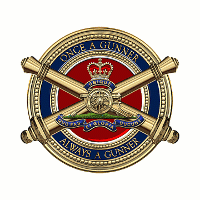 |
|
Dick McNeill was born in Rockdale in 1919. He spent his early years in the Punchbowl area attending local schools. On turning 16 he was enrolled at Hurlstone Agricultural College as a boarder. It was perhaps here that Dick developed an affiliation with agricultural industries and would later see him in the wool industry. While at school, Dick became involved with both Scouts and the local School Cadet Unit.
On tuning 20, Dick did his National Service Training. Dick must have enjoyed both his school cadet years and his time in National Service as he followed on the following year by joining the all-volunteer Second Australian Imperial Force and was allocated to Artillery. His ability with a slide rule may have had some influence on this decision. Dick became a member of the 2/9th Field Regiment which was being formed in the Ingleburn/Holsworthy area.
The Regiment originally consisted of only two batteries – the 17th and 18th but a third battery, the 59th was added in October 1941. The men trained with 18 Pounders but later were able to use the newer 25 Pounders. This could have been the start of a long-time passion of Dicks which saw him purchase his own 25 Pounder in later years.
|
Dick deployed with the 2/9th Field Regiment in April 1941 on board the ‘Queen Elizabeth’ from Sydney Harbour. The Regiment was on route to Egypt and eventually arrived in Kantar where they entrained to Amariya to pick their guns and equipment. The regiment was used to support British troops on alert to defend against a possible German airborne invasion in the wake of the Battle of Crete. The Regiment was also deployed to the Syria-Lebanon campaign where it was largely used to support British forces from the 23rd Infantry Brigade around Merdjayoun. During this time the Regiment trained and used three different guns: 18 Pounders, 25 Pounders and the 4.5-inch howitzers.
In February 1942 the Regiment joined numerous other Australian troops and began preparing for the return to Australia to counter the increasing Japanese threat. On the 6th of March they left Suez on the ‘USS Westport’, arriving in Adelaide, South Australia in March 1942. The Regiment started moving east, collecting their guns and equipment in Springbank, central Victoria before arriving at Esk in south east Queensland. By June 1942 Dick and the regiment found themselves in Arakoon, north Queensland. In October 1942 they were reassigned to the 3rd Division for defensive duties in the Buderim, Maroochydore and Caboolture area. Another reassignment in mid-1943 saw Dick and parts of the regiment sent to garrison Merauke in Dutch New Guinea. They did see some action during this time, but the regiment’s personnel were largely used to complete construction tasks. Dick and the regiment departed Merauke by sea in October 1944 and called in at Thursday Island where they stayed for nearly a month. Dick and the regiment were then in a rebuilding phase stationed at Wondecla on the Atherton Tablelands. Dick finally took his discharge on the 15th November 1945 with the rank of Sergeant.
Dick returned to the wool trade, moving from Punchbowl to Thornleigh and then on to Normanhurst in 1948. His family was growing and Dick, still interested in guns, joined the CMF in the early 1950s. Dick was in uniform and on the streets of Sydney in 1953 for the visit of Queen Elizabeth II. In later years, Dick was the flag bearer for his unit on ANZAC Day. In 1986 Dick started restoring an Australian Short 25 Pounder and a couple of years later, he commenced work on another standard 25 Pounder. Dick would often take these 25 Pounders to various shows and exhibitions with his knowledge and ability to explain to the gun’s workings, very much appreciated by the general public.
|


